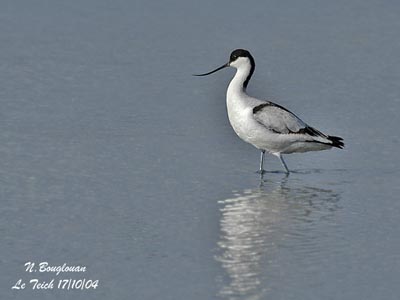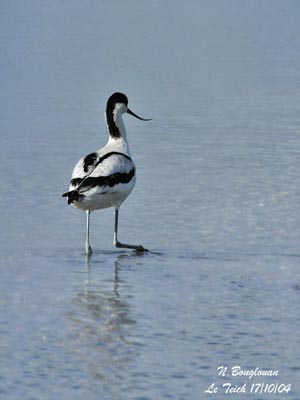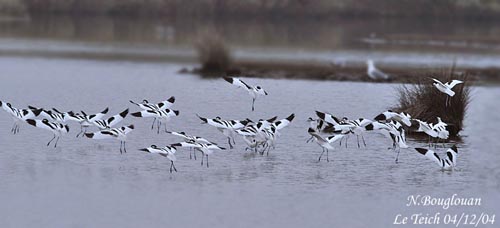
Fr: Avocette élégante
All : Säbelschnäbler
Esp : Avoceta Común
Ital : Avocetta bianca e nera
Nd : Kluut
Sd : Skärfläcka
Photographers :
José Luís Beamonte
Pájaros de España
Jean Michel Fenerole
Photos d’Oiseaux
Niraj V. Mistry
BIRD’S GALLERY
Jean Michel Peers
JMPN PHOTOGRAPHIE
Nicole Bouglouan
PHOTOGRAPHIC RAMBLE
Text by Nicole Bouglouan
Sources :
HANDBOOK OF THE BIRDS OF THE WORLD Volume 3 by Josep del Hoyo-Andrew Elliott-Jordi Sargatal - Lynx Edicions - ISBN : 8487334202
THE HANDBOOK OF BIRD IDENTIFICATION FOR EUROPE AND THE WESTERN PALEARCTIC by Mark Beaman, Steve Madge - C.Helm - ISBN: 0713639601
THE COMPLETE BOOK OF BRITISH BIRDS – Written by “Royal Society for the Protection of Birds” experts - Préface de Magnus Magnusson - Michael Cady- Rob Hume Editors - ISBN: 0749509112
SHOREBIRDS by Peter Hayman, John Marchant and Tony Prater – Christopher Helm – 1986 – ISBN: 0747014035
ENCYCLOPEDIE DES OISEAUX DE FRANCE ET D’EUROPE – de Peter Hayman et Rob Hume - Flammarion – ISBN : 2082009920
GUIDE DES LIMICOLES de D. Taylor - Delachaux et Niestlé - ISBN : 2603014080
BirdLife International (BirdLife International)
Pájaros de España (JL Beamonte)
Pied Avocet
Recurvirostra avosetta
Charadriiforme Order – Recurvirostridae Family
BIOMETRICS:
Length: 42-45 cm
Weight: 225-395 gr
Bill length: M: 82-93 mm – F: 72-85 mm
DESCRIPTION:
The Pied Avocet is an Old World species. This very elegant wader or shorebird is black and white, and shows a conspicuous upcurved long bill.

Both adults have similar plumage, but the female has shorter and more curved bill than male.
Adult has white body with black scapulars and mantle sides. On the upperwing, the outer lesser coverts and the median coverts are black, as the outer six primary flight feathers.
At rest and see in profile, we can see three black bands crossing the white plumage of the wing.
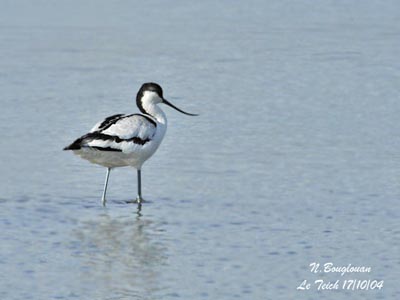
Underparts are white, except the black outer primary flight feathers. This black patch is larger in male.
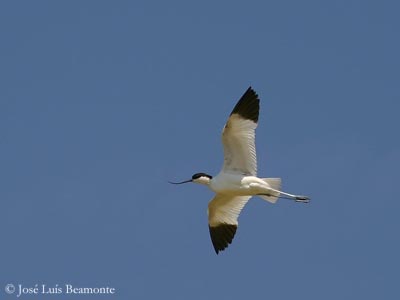
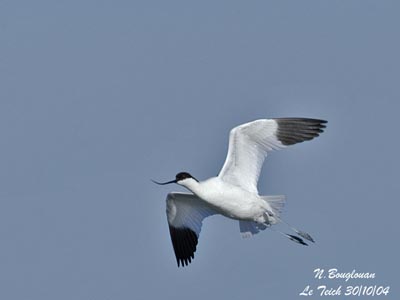
On the head, forehead, crown to below the eyes, nape and upper hindneck are black. Chin, throat, foreneck and cheeks are white.
The long bill is upcurved and black. Eyes are dark brown. Long legs and webbed feet are pale blue-grey.
The juvenile has less contrasted plumage, with the black parts tinged brownish, whereas the white upperparts show sepia, buff or grey-brown mottling.
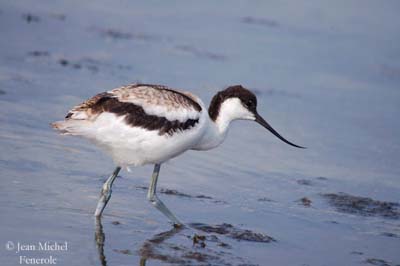
This species keeps the same plumage all year round, without any seasonal variation.
VOICE: SOUNDS BY XENO-CANTO
The Pied Avocet utters a clear “kluit” relatively melodious, and some other similar calls. This call is loud and often repeated.
When alarmed, the same call is given but harsher “kloo-eet” or a shrill “krrreee-yu”.
HABITAT:
The Pied Avocet breeds in flat, open brackish or saline areas with short vegetation. This bird is usually found on lakes, lagoons, salt-pans and estuaries with some vegetation.
Outside the breeding season, it frequents the muddy tidal flats. It may be occasionally seen in freshwater, lakes or rivers.
In the Netherlands, it frequents cultivated areas.
It may be seen up to 3000 metres of elevation in Afghanistan.
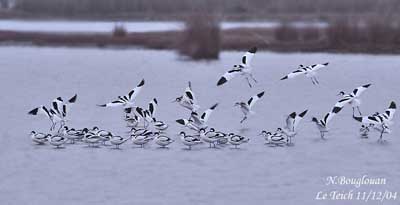
RANGE:
The Pied Avocet breeds in temperate Europe and W and C Asia to SE Siberia and NE China, and locally in N Africa to E and S Africa.
This species winters from W Europe and Africa, through Middle-East to NW India and SE China.
The Pied Avocet is mainly migratory, but populations are present all year round in Africa and in some parts of W Europe.
The strongest migrants are the eastern populations which move to Persian Gulf, NW India and SE China in winter, coming from C Asian breeding areas.
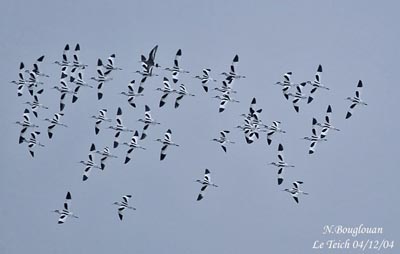
BEHAVIOUR:
The Pied Avocet feeds mainly on aquatic invertebrates such as insects and larvae, molluscs, crustaceans, worms, and also fish and plant materials.
It feeds by picking, or by strong sideway sweeps of the bill. It also performs up-ending. It forages in watery mud and often swims too.
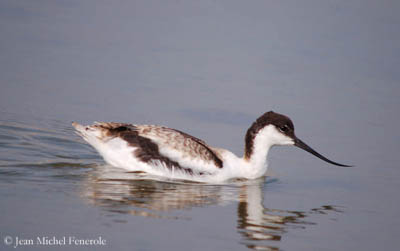
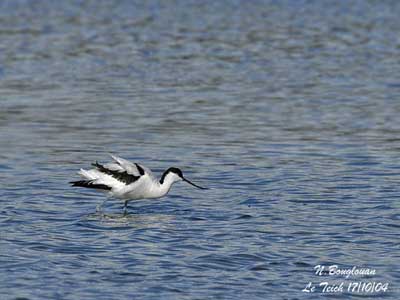
The courtship displays are very active before the copulation. We can observe preening and “bill-dipping”. The bird inclines the head forwards with stiff neck. They raise their bills out of the water, and then immerse them to eye-level. The movements are synchronized between both mates.
Following these displays, the female assumes a soliciting posture in which the head is lowered and the bill almost horizontal. The male moves from side to side in semi-circle behind her. This display is repeated several times. Then, it pauses at her side and performs other displays named “dip-shake-preen display” at each side, during which it may sometimes brush the female’s tail feathers before to mount the female. The copulation occurs quickly.
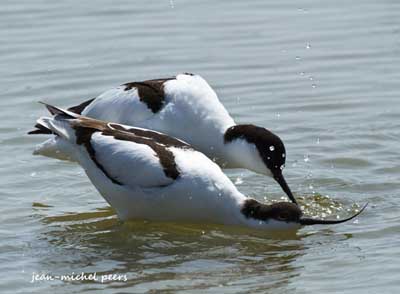
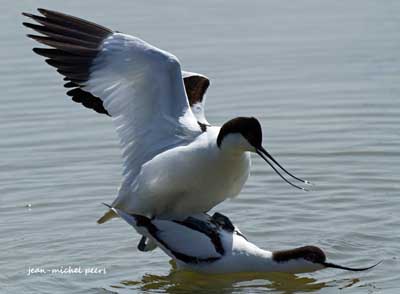
Then, the birds cross their bills and walk forwards together with the head raised and one wing of the male over the female’s back.
During the breeding season, the Pied Avocet becomes very noisy and aggressive. They drive off larger birds such as shelducks. The birds lower head and neck, and chase the intruders which enter the nest-site and approach the nest.
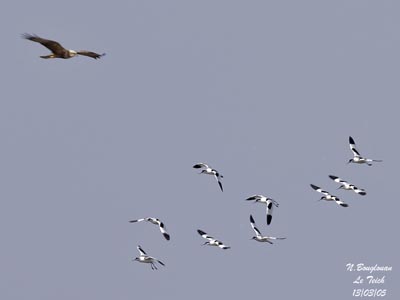
Flock disturbed by a
They often roost in large flocks on dry banks or sometimes standing in water. They also breed in colonies close to the water. These birds are gregarious, with nests moderately to closely spaced, and colonies may contain 5 to 100 pairs.
Outside the breeding season, the Pied Avocet forages in flocks and the birds probably defend individual distances.
If alarmed and threatened when feeding or roosting, the birds bob the head, extending the neck and retracting it rapidly.
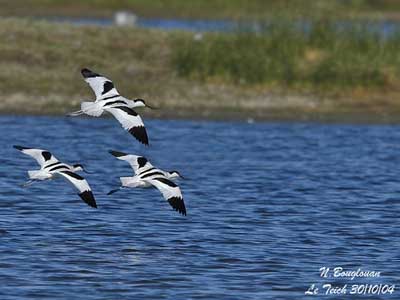
FLIGHT:
The Pied Avocet flies on stiff, straight wings and often in dense flocks. The black and white pattern of the upperparts is very conspicuous, and mainly when flying in flocks.
During the migrations, they fly in loose lines and usually fairly low. The legs trail behind and the neck protrudes in front. The wing beats are rapid and steady.

REPRODUCTION:
Breeding season occurs between April and August in Eurasia.
The Pied Avocet nests in large colonies. The nest is a scrape in open area or amongst short vegetation. The cup is lined with grass.
Female lays 3-4 buff-white eggs. Incubation lasts about 23-25 days shared by both parents. The chicks are covered in silver-grey down above, becoming buff on head sides, wings and sides of back, and they have some spots on the crown. We can already see two lines of larger parallel spots on the back. They are nidifugous and fledge about 35 to 42 days after hatching. They can breed at 2-3 years.
DIET:
The Pied Avocet feeds primarily on aquatic invertebrates such as insects, crustaceans, worms, some molluscs, and also fish and plant matter. It feeds by picking or by sweeping laterally with the bill in the watery mud.
PROTECTION/THREATS/STATUS:
The Pied Avocet is threatened in Europe by pollution of wetlands (insecticides, lead and mercury), and human disturbances.
The species is not globally threatened, being locally abundant in most of Africa, and about half of populations breeding in Europe. We can notice some increase in the northern parts of the range.
